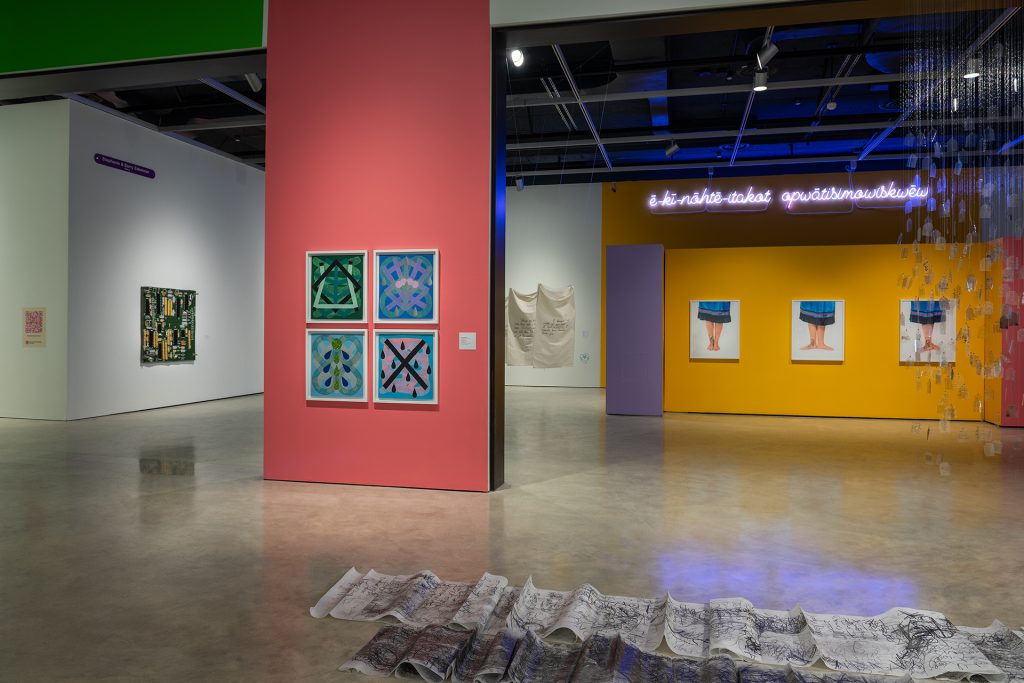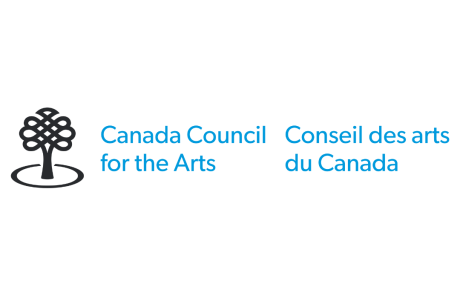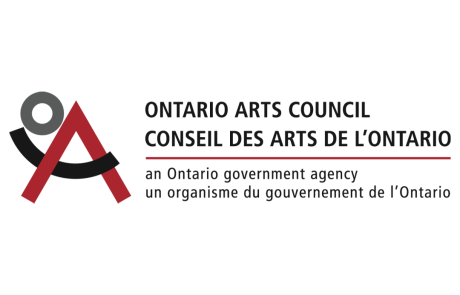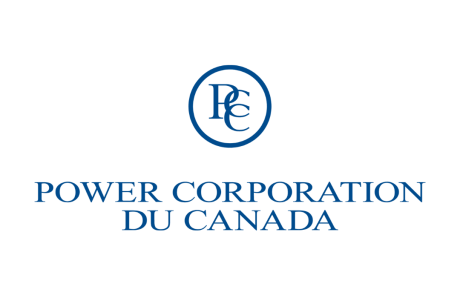Love Languages:
Ktahwaalul | I love you
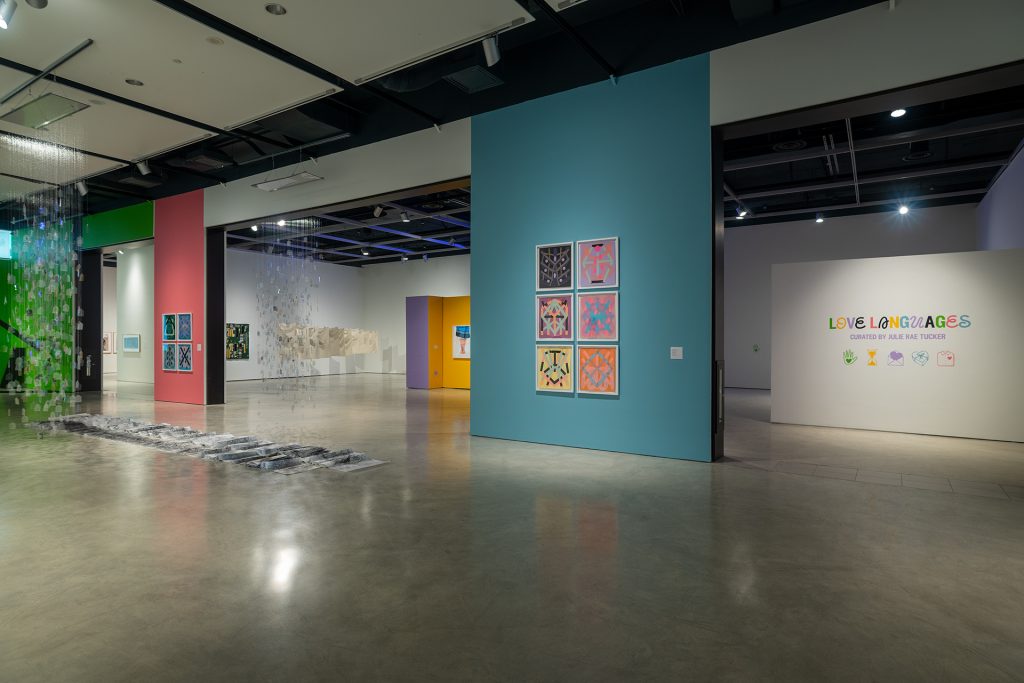
Photography Credit to Frank Piccolo
by Julie Rae Tucker
I don’t know you, but I love you.
- Lacey George, Every Child Matters walk, Windsor, Ontario, 2021 (1)
The word “love” is most often defined as a noun, yet…we would all love better if we used it as a verb.
- bell hooks (2)
Intro /// ♫ Love ♫ – Air (3)
Love Languages was imagined during the disaster cloud that was known as the COVID-19 Pandemic. About a year before, I began working with a collective of band members from Munsee Delaware First Nation to develop language and history curriculum for our community members. The late Karen Mosko-aya was our teacher in our community, who taught folks in the Lunaape homeland in New Jersey and beyond. Another collaborator was the late Chief Mark Peters-aya. We were learning in a way that did not center one person’s knowledge and that we all had something to share. Learning your Indigenous language, at first, is very meaningful and empowering.
The Munsee dialect of huluniixsuwaakan is a critically endangered language. My late cousin, Christopher Young-ba, sent me a meme of an Ewok illustrating this in a way that was supportive and poking fun at the power of learning one’s own Indigenous language. After that, when the “ewok-ness” of it all wears off, there is a strong sense of grief for all the questions left unanswered and the abrupt end of opportunities to learn from the folks I mentioned above.
All of this to say that, what I was thinking about language revitalization, to truly understand or to think differently, or to see another perspective that is not yet your own, is possible through learning another language. This includes music, dance, math and language outside a particular language family or system.
In her book, The Power of Language, author Viorica Marian states that “engaging with a variety of languages gives us the crucial abilities that the human race will need to heal burgeoning social discord and formulate solutions to looming global problems.”(4) To want to shift your perspective is to live your life with a love ethic.
In all about love, bell hooks believes that love, as an ethic, should drive our whole lives and our relationships with friends and love partners so we can feel that interconnectedness, “Embracing a love ethic means we utilize all dimensions of love; “care, commitment, trust, responsibility, respect and knowledge”-in our everyday lives.(5) I knew when I heard Lacey George’s words, “I don’t know you, but I love you,”(6) that I was on the right path to bind love to language and an artist’s raisons d’être to make and think about what that means to be an artist in the time we are in.
Our education team did a tour with grade 5 students, and a kid said the exhibition “tickled their brain,” a feeling I think is akin to love from a young person who is open to understanding a new perspective through art.
Always on My Mind: ♫ A Crazy Little Thing called Love ♫ – Queen (7)
Through this exhibition, I wanted to bring my thoughts on language revitalization. A thematic group show operates like a good playlist, a sonic tapestry of artist materials engaging the audiences’ senses beyond sight. There is a diversity of languages present, which also challenges what folks consider language. I think about the ways technology has impacted language learning.
I am currently taking Zoom classes hosted by Stockbridge-Munsee in Wisconsin by a language teacher in Bucktown (or Eelūnaapèewii Lahkèewiit), 45 minutes away. It has been so great to see the ways in which technology can connect the Lunaape diaspora and in the future, will connect us to our cultural objects, which were stolen by museums.
My labour on this show came at the same time as I was experiencing personal and community losses; bell hooks reminds us, just as every knowledge keeper has reminded me, “Understanding that death is always with us can serve as the faithful reminder that the time to do what we feel called to do is always now.”(8) Through the beautiful work in Love Languages is, I think, joy and grief playfully entangled.
A reality tv show set up: ♫ Love Me Harder ♫ – Ariana Grande(9)
In the exhibition design, I wanted to reference reality TV sets through colour choice (Love Island) and to create a “backstage,” a perfect backdrop for a blind dating show. During my nights as a shift widow, in and out of lockdown, I would binge reality shows, noting how love languages were discussed by cast members. I saw that the medium shows a great understanding of Gary Chapman’s 1992 book, The 5 Love Languages: How to Express Heartfelt Commitment to your Mate. Multiple versions of the book, which spawned a self-help empire, have been published, encouraging people to reflect on how love is shared and received in relationships. Chapman is a Christian minister; his counselling of Christian couples informs his theory that we each have our own ways of giving and receiving love.(10)
I asked each artist the same question: to name their works’ love language. A love icon for each love language is hand-painted near each artist’s works and a room adjacent to the exhibition galleries houses quizzes marked by a double heart. The quiz helps visitors to find their love languages and then encourages them to evaluate if their favourite artwork matches their primary love language. This exhibition’s title is a playful response to the famous text, expanding narrow definitions of relationships in Chapman’s work to how love is expressed through artistic practices. The title wall is lovingly designed and hand-painted by Windsor-based artist Julie Hall.
I also asked the artists if they were on a reality TV show, which show would they be good on? Answers included: ManHunter, Alone, Junk Brothers, The Apprentice, Storage Wars, and RuPaul’s Drag Race.
Quality time: Michael Belmore, Susan Blight, Sanaz Mazinani + Mani Mazinani
Quality time is the language of togetherness and active communication. This language requires time and space for active listening and reflection. Artists think a lot about time and generations past, present and future. It is interesting to me that two Anishinaabe artists chose to think about their work’s love language as quality time.
In Susan Blight’s work, On Occasion of our Small Gatherings, the artwork, a hooked rug, illustrates the hard work and joy of being able to speak and text in Anishinaabemowin.(12) In my experience, textiles speak to a wide audience. There seems to be a broader understanding of the labour involved in their creation, perhaps because people have seen textiles produced in their own homes, so the process of making them is less mysterious. Blight’s words are powerful affirmations about the people who are in community together and their kinship that braids them together. The translation “You’re doing great cousin,” echoes my understanding that cousins are the siblings you choose. In the tv show The Bear, whenever they yell “COUSIN!,” it reinforces that familial bond, whether family or otherwise. (You can only be truly mean to someone you love and spend a lot of time with.) The right to Indigenous language is legislated by the Canadian government; however, there is not a clear plan and only limited funding exists to support Indigenous language learning in Canada.(13) Despite this, Anishinaabe is growing strong; Blight’s work offers the statement, “Our Language will Survive.”
Michael Belmore’s work is rich with materials from an Anishinaabe worldview of the South Shore on Isle Royale. This is a rare place in the world where copper is found naturally on the surface of the earth. Belmore said that copper, “is the thing that connects our houses, our phones, our connection to our communities. It runs down every single road, into every single house, into every single room, and all through the room. It’s the thing that keeps out the darkness. It’s the thing that turns on the lights. It’s the thing that gives us comfort. It’s the thing that gives us heat. It’s the thing that allows us to be who we are, and I think that’s important, so that’s why I use copper.” When I asked him about what language his work is speaking, he said, “These pieces are using the language of binary code, which is a universal language that we all speak and we all utilize, we just don’t understand it.”(14) Belmore’s work speaks to what connects us through his material – time (Anishinaabe philosophy of relationality to the worlds we occupy and are connected to other planes of existence).
Siblings Mani and Sanaz Mazinani created the work, What Languages are they Speaking? (2016-2024) a six-channel sound installation. The sound hits large and ambient;depending on where you are standing, you might hear the sound of an airplane taking off, the sound of waves against a boat, the sound of conversations, or a combination of all of these. The work is a constellation of languages spoken in places like Windsor as one of the most diverse cities in Canada. In one channel, Mani tells a story about a contraband cassette that crossed the Iranian border with him, Sanaz, and their mother in 1987. While crossing on a bus, a man hid his cassette under Mani’s seat. The cassette went undetected by border guards and the man joyfully celebrated that he was able to keep this tape. They left during the First Gulf War حرب الخليج الأولى (harb alkhalij al’uwlaa) (Farsi) to live in Windsor, where their father was studying at the University of Windsor. What Language Are They Speaking? is communicating the sounds of a border crossing of a family seeking safety. How does the story resonate with you? How much time are you giving to thinking about global conflicts that are happening right now?(15)
Joan Tronto says, “Caring requires that one start from the standpoint of the one needing care or attention. It requires that we meet the other morally, adopt that person’s, or group’s, perspective and look at the world in their terms.”(16) We live in a tinderbox with two opposing sides, what Naomi Klein calls the “Mirror World;” simply put, one side believes the exact opposite, forever in opposition. I read white supremacist signs this summer in cottage country outside of Ontario’s most beautiful town, “Goderich, Ontario. White Lives Matter.” I think caring can be easily co-opted, as the BLM movement’s words have been co-opted by white supremacy. “A love ethic presupposes that everyone has the right to be free, to live fully and well.”(17)1 Do we really believe that? How can we collectively adopt a love ethic within and between our towns, community, nation(s)?
Words of affirmation: Joi Arcand, Ed Janzen + Collette Broeders, Anne Riley
Words matter and have the power to make change. This exhibition features words at its center. All the works feature languages, text, or symbolism to speak to the audience. I think that words of affirmation are more than platitudes. I dislike compliments. To me, compliments are information that I must submit, evaluate, and organize in my already overextended brain juices. What I do appreciate is a remark that tells a story about how the thing, whatever it is, affects a person to think or feel differently or something.
Joi Arcand’s work is connected to her language, culture and her grandmother. She recently graduated with a BA in Nêhiyawêwin from Blue Quills University. A widely-known Cree word, kokum, means “your grandmother”. The word’s meaning was adapted through second language learners not fluent in the language due to systematic cultural genocide and the prohibition of Indigenous languages in Indian Residential schools. Since learning this about Cree, another language in the Algonquian language family, I can more easily understand the Munsee dialect. We both use the same letter at the beginning, ‘N’ for my letter and ‘K’ for your letter. Knowing this doesn’t mean that kokum is incorrect; it just reflects the reality that languages change. The rigidity of educators and learners, the impact of residential schools, and English’s influence have created a fear of inaccuracy and a need for perfectionism when re-learning your language. There are different ways to say the same things, different dialects, and different spellings; language learners have to be more kind to themselves and each other. About the use of Plains Cree in her work, Joi says, “It’s become central in my work because I love my language and learning a language is an act of love. It’s an immensely deep act of love that reaches through like generations.” Through her words, “I used to want to be a fancy dancer,” and “I used to want to be a ballerina,” there are sadnesses in Arcand’s work; the language of dance is never mastered, and childhood dreams are never realized. (18)(19) She describes this as, “That feeling that is so intertwined with love, I think, is like pining, yearning, and longing.”(20) Joi’s work is at the center of the exhibit because of the space she takes up for her language.
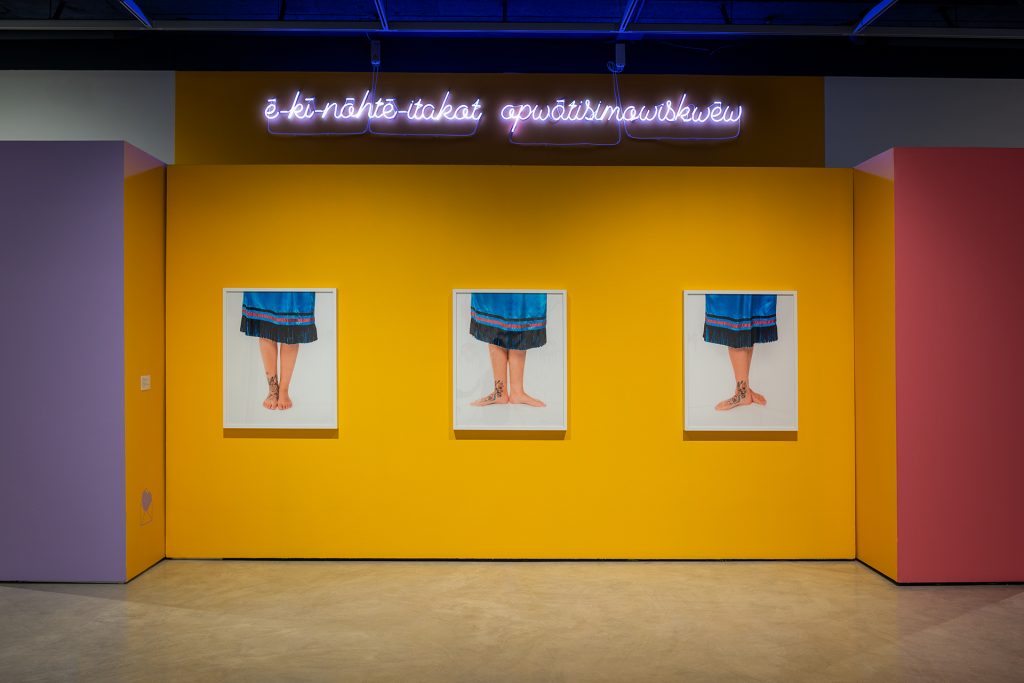
Photography Credit to Frank Piccolo
Anne Riley’s film was commissioned during the Covid-19 pandemic; she shares real-time thoughts on what it means to make art during the pandemic. Like many other folks, Anne was using this time for language learning at a time when language classes and resources became more readily available. Riley speaks about learning Dene and the feeling and significance of learning the phrase, “I love you.” Anne never offers the translation; I admire this refusal in the work. Throughout the video, she talks about the work she wants to create. It is not until the end that the viewer realizes they are already watching the work being described. There is humour captured in breaking the 4th wall as Anne acknowledges that the work that you are watching is, indeed, the work she wanted to make.(21) The film plays on a TV situated below the soft glow of Joi Arcand’s neon artwork. A comfortable couch is placed along the wall, as the artist requested.
Ed Janzen and Collette Broeders, Windsor-based artists who began working together in 2020, form the other duo in the show. Their work involves a collection of over 700 letters of love, which they perform with their whole bodies during a durational drawing performance. They develop rules for their work; often, the prompt is a sentence, in this case, love letters collected from all over the world. Words on acetate tags float, cloud-like, around their performance space. The words are largely unreadable and abstracted for the audience. Before each performance, the artists selected the tags and performed them over a three-hour time period. The artists went barefooted on their knees, making marks using graphite sticks on long scrolls of paper that remained in the installation as remnants of each of the seven performances. This work is much loved by local community members who offered their very personal reflections.
Acts of service – Jaime Angelopoulos
Joan Tronto states, “we are givers and receivers of care.”(22) I think that Jaimie Angelopoulos understands this well. Works of art often demand something from the audience; Jamie’s do not. Angelopoulos offers a powerful message in her own visual language. The works are beautiful and evoke power symbols of the heart, femininity, and Greek symbology that ultimately connect to story. We know these stories and they are complicated. What folks miss about her work is that they are laborious and hand-rendered using materials from hardware stores. Magically, they look born from machines but, on careful review, you can see the hand-work throughout.
Jaime’s work pays homage to the strength and power of femme in her series of sculptural works that center a double intertwined heart. In a world that doesn’t respect femininity, out of the pandemic, there is a rise in abuse of women, 2SLGBTQi+ and children. Recently, local MPP, Lisa Gretzky, called repeatedly for a declaration of an Intimate Partner Violence Epidemic.(23) Acts of service can simply refer to household tasks performed by women, but Jaimie’s work is able to create another narrative in love languages. It is about codifying emotions. Her works point to femme stories, present and future, making their mark. These works are activated in the viewer’s proximity. A love ethic is the ultimate act of service as the artist states, “art is for everyone.”(24)
Physical touch: David Bobier, Erika DeFreitas
My colleague, Emily McKibbon (Art Windsor-Essex Head of Exhibitions and Collection), offered me the term “ambiguous loss” in understanding Erika DeFreitas’s beautiful work, Holding one’s breath (November 8, 1973 – August 1, 1975). We were lucky to show this work for the first time in Canada; it was one of the last works chosen for the exhibition.(25) The work illustrates the physical untethering from your home and your mother, to cross into a different culture and way of living.
Ambiguous loss is a person’s profound sense of loss and sadness that is not associated with a death of a loved one. It can be a loss of emotional connection when a person’s physical presence remains, or when that emotional connection remains but a physical connection is lost. Often, there isn’t a sense of closure.(26)
Through writing this essay, I came to know that this idea of ambiguous loss is an almost constant feeling of being disconnected to culture, language and land. The joy and grief of learning a critically endangered language is that knowledges will forever be lost to you, and having to reconcile that within yourself.
David Bobier’s work is both a plea and an invitation to touch. In his work, called “Love me…,” a chorus of violins plays 35 different languages saying “love me” while connected to a pillow embroidered with “love me” in English, Braille and American Sign Language (which allows you to pick it up and feel the language).(27)
Bobier states in my interview with him, “for me, vibration is a language. So the key part of my work is based on the vibro-tactile – feeling sound – and I guess that comes from having hearing loss and raising two deaf children. So the key thing there was the observation of my kids and how they experience sound.”(28)
When we toured this exhibition with students, they would line up behind the sound pillow on the music stand. One student, who had recently emigrated from Ukraine, was very excited to learn if they could hear Ukrainian. We saw his face change as he picked up the pillow at the exact time Ukrainian was being said, “люби мене.”
In high school, I read Milan Kundera’s book, The Book of Laughter and Forgetting(29)” around the same time that I started to learn about the residential school system. The book introduced the concept of “organized forgetting.” Canada did this through the Indian Act, the residential school system, the Potlatch and ceremony bans, and forced removals; all were purposed to erase nations. The famous quote, “Forgetting is form of death of present within life” was something I carried with me, yet, what I have learned by re-learning a critically endangered language is that it is not, in fact, dead but rather sleeping, waiting to be embraced like Bobier’s pillow.(30)
Gifts: Laura Moore
Gifts are sometimes more than a material object; the intention of the person offering the gift acknowledges the meaning and value of the relationship. (At least this is how I think of gifts.) In Laura Moore’s practice of quiltmaking, she has been gifted work clothing from fellow artists, including Tim Whiten, a colleague from OCAD U. AWE was gifted two works from Tim Whiten; I love that we have another incarnation of the artist’s practice existing inside the gallery. I have also mailed Laura a work shirt from the Windsor-based artist, Zeke Moores, who is also in the collection, so that a future quilt could be made.
Laura’s memory quilts are meant to represent enlarged circuit boards that hold memory and are found inside obsolete electronics, as in Nintendo controllers and games, digital cameras, and cell phones. The guts of the electronics and the memory is usually hidden inside. Despite the coldness and waste the imagery represents, it is welcoming to see these little things enlarged from the microcosm that are so vital to everyday life.(31)
To close: ♫ True Love ♫ – Jesso Jr. Tobias(32)
During a gathering on Lunaaphoking. I just learned that there are more than 30 ways to say I love you in the Munsee language. I know only one – Ktahwaalul.
My brother sent me Dallas Hunt’s book of poetry, Teeth. The first poem opens with a reference to the reality tv show, Alone. This poem, about a reality show, is analogous to what it is like to be an artist. If you are fortunate, the award for an artist is much less, perhaps 100k for a Sobey’s Art Award.
ANKWACAS
For intolerable bodily pain, as well as
The physical sting of loneliness for this,
For outlasting their
Fellow competitors,
Who are at a remove,
One will win $500,000(33)
I made this show to show how much I love and respect artists, language warriors and Survivors of Canada’s residential school system and all they do to show us how to love better and live in this world in a good way.
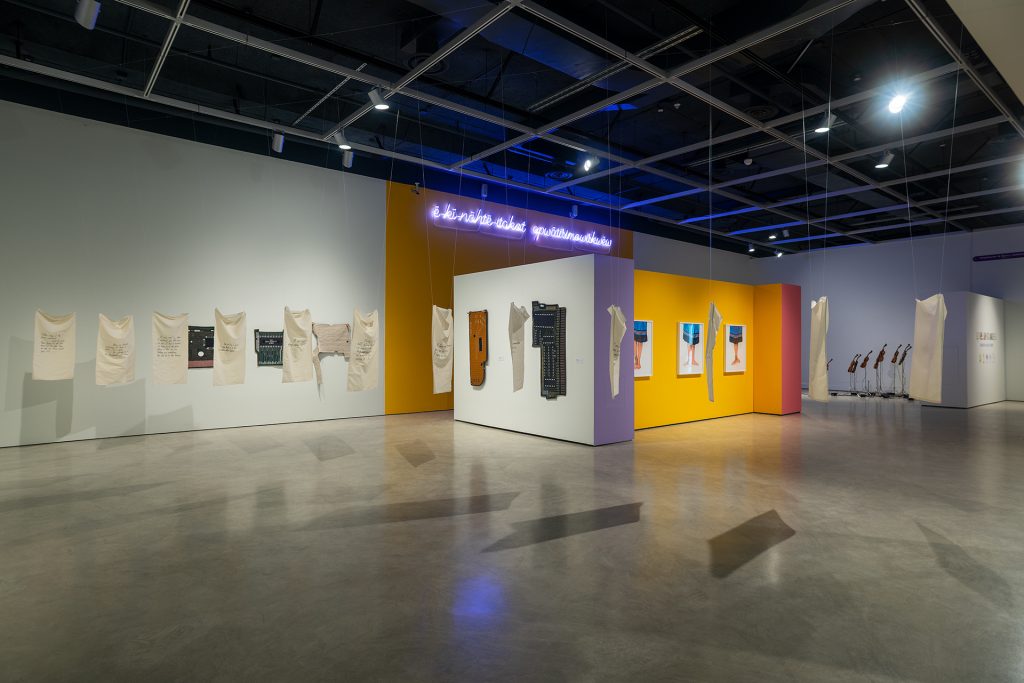
Photography Credit to Frank Piccolo
Here are some songs that resonated with me while writing this. I wanted to connect you to what I was feeling when I wrote.
♫ How deep is your love ♫ – The Rapture
Never my love – the Association
Everyone wants to love you – Japanese Breakfast
Black is the colour of my true love’s hair – Nina Simone
Cruisin’ – Smokey Robinson
Loves Grows (Where my Rosemary’s goes) – Edison Lighthouse
Friday I’m In love – The Cure
Kiss from a rose – Seal
You’re Still the one – Shania Twain
Your Song – Elton John
Always be my baby – Mariah Carey
END
June 20, 2024 – October 27, 2024, Art Windsor-Essex
With works by: Jaime Angelopoulos, Joi T. Arcand, Michael Belmore, Susan Blight, David Bobier, Erika DeFreitas, Ed Janzen + Collette Broeders, Laura Moore, Sanaz Mazinani and Mani Mazinani and Anne Riley.
fOOTNOTES
1. I don’t know you, but I love you, Lacey George, Every Child Matters Walk, Windsor, ON, September 30, 2016.
2. bell hooks, All About Love : New Vision. (New York: Perennial, 2000) 4.34. 2000), 4.
3. Air, “Love,” Nicolas Godin and Jean-Benoît Dunckel, recorded ca. 2009, Virgin Records, track 2 on Love 2, 2009, digital album.
4. Viorica Marian, The Power of Language : How the Codes We Use to Think, Speak, and Live Transform Our Minds. (New York: Dutton, 2023) 4.
5. Bell hooks, All About Love : New Vision. (New York: Perennial, 2000), 94.
6. I don’t know you, but I love you, Lacey George, Every Child Matters Walk, Windsor, ON, September 30, 2016.
7. Queen, “Crazy Little Thing Called Love,” Roger Taylor et al., recorded June – July 1979, EMI Records, track 5 on Game, 1980, digital album.
8. bell hooks, All About Love : New Vision. (New York: Perennial, 2000) 4.34. 2000), 203.
9. Ariana Grande, “Love Me Harder,” Ariana Grande and The Weeknd, recorded 2014. Republic Records, track 9 on My Everything, 2014, digital album.
10. Gary Chapman, The 5 Love Languages : How to Express Heartfelt Commitment to your Mate. (Chicago: Northfield Publishing, 1992).
11. Kendrick Lamar, “LOVE.,” Kendrick Lamar and Zacari, recorded 2016, Interscope Records, track 10 on Damn, 2017, digital album.
12. Susan Blight, On Occasion of our Small Gatherings, 2019, hooked rugs, dimensions variable, Art Windsor-Essex, Windsor, Ontario.
13. Canada. Bill C-91, An Act respecting Indigenous languages, 1st session., 42nd Parliament, 2015-2016-2017-2018-2019, SC 2019. https://www.parl.ca/LegisInfo/en/bill/42-1/C-91
14. Michael Belmore, Speechless, 2014, copper, 24x16x24 inches, Art Windsor-Essex, Windsor, Ontario.
15. Mani Mazinani and Sanaz Mazinani, What Languages are they Speaking?, audio recording, 3:03 minutes..
16. Joan C. Tronto. Moral Boundaries : A Political Argument for an Ethic of Care. (New York: Routledge, 1993) 19.
17. Joan C. Tronto. Moral Boundaries : A Political Argument for an Ethic of Care. (New York: Routledge, 1993) 19.
18. Joi Arcand, ē-kī-nōhtē-itakot opwātisimowiskwēw (she used to want to be a fancy dancer), 2019, neon sign, 596x x 6 x 53 cm, University of Saskatchewan, Saskatoon, Saskatchewan.
19. Joi Arcand, she used to want to be a ballerina (for grandma Vivian), 2019, colour print, 38 11/16 x 94 3/8 x 12 1/4 inches, Indigenous Art Collection, Crown-Indigenous Relations and Northern Affairs Canada, Gatineau, Quebec.
20. Joi Arcand, Joi Arcand Interview, Julie Rae Tucker, Art Windsor-Essex, August 15, 2024, audio recording, 14:56, https://storymaps.com/stories/4243eb2b86e74b74b503df75b37fe43b.
21. Anne Riley, The Heart of the Matter, directed/performed by Anne Riley (2020/2021), video.
22. Joan C. Tronto. Moral Boundaries : A Political Argument for an Ethic of Care. (New York: Routledge, 1993) 19.
23. “MPP Gretzky renews call for declaration of Intimate Partner Violence epidemic after another tragedy,” Ontario NDP, May 30, 2024, https://www.ontariondp.ca/news/mpp-gretzky-renews-call-declaration-intimate-partner-violence-epidemic-after-another-tragedy.
24. Jaime Angelopolous. Clairvoyant, Cannot be Destroyed, Cosmic Flame Water, Crystallized by Fire, Emerald Tree Heart, Friendship, Heart Crystals, Intersectional Goddess League, Onyx Heart, Orchard Heart, Sacred Geometries, Silver Heart Water, Sun Womxn Lung, The Chanting Bones, Tiger Fire Heart, Violet Eye Rebel. 2019 – 2022, sculpture, various.
25. Erika DeFreitas. Holding one’s breath (November 8, 1973 – August 1, 1975). 2013, embroidery installation, various.
26. Rich Oswald, “Unnamed pain: Coping with ambiguous loss,” Speaking of Health, Mayo Clinic Health System, April 10, 2023, https://www.mayoclinichealthsystem.org/hometown-health/speaking-of-health/coping-with-ambiguous-grief .
27. David Bobier, Love Me… 2024, audiovisual installation, Art Windsor-Essex, Windsor, Ontario.
28. David Bobier, David Bobier Interview, Julie Rae Tucker, Art Windsor-Essex, September 19, 2024, audio recording, 13:54, https://storymaps.com/stories/4243eb2b86e74b74b503df75b37fe43b.
29. Milan Kundera, The Book of Laughter and Forgetting, trans. Michael Henry Heim (New York: Alfred A. Knopf, Inc, 1980), 234.
30. Milan Kundera, The Book of Laughter and Forgetting, trans. Michael Henry Heim (New York: Alfred A. Knopf, Inc, 1980), 274.
31. Laura Moore. International Stud Sensor, Original Nintendo Controller, Nintendo Skate or Die, EDI, TYrIB, Nintendo Gameboy Tetris, Atari Pinball, Canon Digital Camera. 2021 – 2023, textile sculpture, various.
32. Jesso, Tobias, Jr., “True Love,” n.d., True Panther Sounds, track 1 on True Love (single), 2015, digital recording.
33. Dallas Hunt, “ANKWACAS,” in Teeth (Gibsons, British Columbia: Nightwood Editions, 2024), 11.
BIBLIOGRAPHY
Air. Love. Nicolas Godin and Jean-Benoît Dunckel. 2009. Track 2 on Love 2. Virgin Records, digital album.
Angelopolous, Jaime. Clairvoyant, Cannot be Destroyed, Cosmic Flame Water, Crystallized by Fire, Emerald Tree Heart, Friendship, Heart Crystals, Intersectional Goddess League, Onyx Heart, Orchard Heart, Sacred Geometries, Silver Heart Water, Sun Womxn Lung, The Chanting Bones, Tiger Fire Heart, Violet Eye Rebel. 2019 – 2022, Sculpture, Various.
Arcand, Joi. ē-kī-nōhtē-itakot opwātisimowiskwēw (she used to want to be a fancy dancer). 2019. Neon sign, height × width × depth (unit conversion). University of Saskatchewan, Saskatoon, Saskatchewan.
Arcand, Joi. Joi Arcand Interview. Julie Rae Tucker. Art Windsor-Essex. August 15, 2024. Audio recording, 14:56. https://storymaps.com/stories/4243eb2b86e74b74b503df75b37fe43b.
Arcand, Joi. she used to want to be a ballerina (for grandma Vivian). 2019. Colour print, height × width × depth (unit conversion). Indigenous Art Collection, Crown-Indigenous Relations and Northern Affairs Canada, Gatineau, Quebec.
Bobier, David. David Bobier Interview. Julie Rae Tucker. Art Windsor-Essex. September 19, 2024. Audio recording, 13:54. https://storymaps.com/stories/4243eb2b86e74b74b503df75b37fe43b .
Bobier, David. Love Me…. 2024. Audiovisual installation. Art Windsor-Essex, Windsor, Ontario.
Canada. Bill C-91, An Act respecting Indigenous languages, 1st session., 42nd Parliament, 2015-2016-2017-2018-2019, SC 2019. https://www.parl.ca/LegisInfo/en/bill/42-1/C-91
Grande, Ariana. Love Me Harder. Ariana Grande and The Weeknd. 2014. Track 9 on My Everything. Republic Records, digital album.
hooks, bell. All About Love : New Visions. New York: Perennial, 2000.
Hunt, David. “ANKWACAS.” In Teeth, pg. 11. Gibsons, British Columbia: Nightwood Editions, 2024.
Kundera, Milan. The Book of Laughter and Forgetting. Translated by Michael Henry Heim. New York: Alfred A. Knopf, 1980.
Lamar, Kendrick. LOVE. Kendrick Lamar and Zacari. 2017. Track 10 on Damn. Interscope Records, digital album.
Marian, Viorica. The Power of Language : How the Codes We Use to Think, Speak, and Live Transform Our Minds. New York: Dutton, 2023.
Mazinani, Mani and Mazinani, Sanaz. What Languages are they Speaking? Audio recording, running time.
Moore, Laura. International Stud Sensor, Original Nintendo Controller, Nintendo Skate or Die, EDI, TYrIB, Nintendo Gameboy Tetris, Atari Pinball, Canon Digital Camera. 2021 – 2023, textile sculpture, various.
“MPP Gretzky renews call for declaration of Intimate Partner Violence epidemic after another tragedy,” Ontario NDP, May 30, 2024, https://www.ontariondp.ca/news/mpp-gretzky-renews-call-declaration-intimate-partner-violence-epidemic-after-another-tragedy.
Oswald, Rich. “Unnamed pain: Coping with ambiguous loss,” Speaking of Health, Mayo Clinic Health Systems. April 10, 2023. https://www.mayoclinichealthsystem.org/hometown-health/speaking-of-health/coping-with-ambiguous-grief .
Riley, Anne. The heart of the matter. Directed/Performed by Anne Riley. 2020/2021. video.
Queen. Crazy Little Thing Called Love. Roger Taylor, Freddie Mercury, Brian May, and John Deacon. 1979. Track 5 on Game. EMI Records, digital album.
Jesso, Tobias, Jr. True Love. 2015. Tobias Jesso Jr. Track 1 on True Love (single). True Panther Sounds, digital recording.
Tronto, Joan C. Moral Boundaries : A Political Argument for an Ethic of Care. New York: Routledge, 1993.
PLAYLIST BIBLIOGRAPHY
Air. Love. Nicolas Godin and Jean-Benoît Dunckel. Track 2 on Love 2. Virgin Records, digital album.
Carey, Mariah. “Always Be My Baby.” recorded 1994 – 1995. track 5 on Daydream. Columbia Records, digital album.
Edison Lighthouse. “Love Grows (Where My Rosemary Goes).” recorded ca. 1971. track 6 on Already. Bell Records, digital album.
Grande, Ariana. Love Me Harder. Ariana Grande and The Weeknd. Track 9 on My Everything. Republic Records, digital album.
Japanese Breakfast. “Everybody Wants to Love You.” recorded July 2016. track 2 on Japanese Breakfast on Audiotree Live. Audiotree Music, digital album.
Jesso, Tobias, Jr. True Love. 2015. Tobias Jesso Jr. Track 1 on True Love (single). True Panther Sounds, digital recording.
John, Elton. “Your Song.” recorded January 1970. track 1 on Elton John. DJM Records, digital album.
Queen. Crazy Little Thing Called Love. Roger Taylor, Freddie Mercury, Brian May, and John Deacon. Track 5 on Game. EMI Records, digital album.
Robinson, Smokey. “Cruisin’.” recorded 1978 – 1979. track 7 on Where There’s Smoke…. Motown Records, digital album.
Seal. “Kiss from a Rose.” recorded ca. 1994. track 6 on Seal (Seal II). Sire Records, digital album.
Simone, Nina. “Black Is the Colour of My True Love’s Hair.” recorded October 1959. track 1 on Nina Simone at Town Hall. Colpix Records, digital album.
The Association. “Never My Love.” recorded March and June 1967. track 7 on Insight Out. Warner Bros. Records, digital album.
The Cure. “Friday I’m in Love.” recorded ca. 1992. track 1 on Wish. Fiction Records, digital album.
The Rapture. “How Deep is Your Love.” recorded 2010. track 10 on In the Grace of Your Love. DFA Records, digital album.
Twain, Shania. “You’re Still The One.” recorded ca. 1997. track 10 on Come on Over. Mercury Records, digital album.
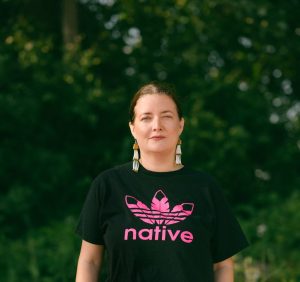
Photo taken by Shayenna Nolan
Julie Rae Tucker is a Windsor-based artist, curator, and cultural worker. She is the Head of Programs & Projects at Art Windsor Essex. She holds an MFA from the University of Windsor and a BFA from Nova Scotia College of Art & Design. Her work as an artist and curator has been shown across Canada and internationally. She is Lunaapeewi from the Munsee Delaware First Nation and is of settler descent. In 2024, the exhibition Nii Ndahlohke / I Work, co-curated with Dr. Mary Jane Logan McCallum, won the awards, Exhibition of the Year Budget over $20,000 Thematic from Galeries Ontario / Ontario Galleries and a Community Impact award from the Association of Tribal Archives, Libraries and Museums.

